Posted by: Ken @ 1:43 pm
Looking south, down the road atop the 196th Avenue levee:
When you live in South Florida you are never very far away from a canal. Canals, and their smaller cousins, ditches, were the beginning of the destruction of the Everglades. Canals and ditches lowered the water table and shortened the hydroperiod (the period of time during which a wetland is covered by water), and the amount of food available for creatures that need more water for survival. Levees are a by-product of canals and ditches, because digging them produced a convenient source of fill for roads that provided access for agriculture, mining, and development. In New Mexico, roads had “borrow ditches” (usually pronounced “bar ditches”) that remained along either side, to provide runoff channels for snow melt or monsoon rains.
Most highways and through streets in South Florida have canals that follow them along on one side or the other. Roads further impede the sheet flow (movement of water over the land surface in a thin layer) that is so essential to the River of Grass. From the air, it is easy to see how roads that traverse the Everglades act as dams. Water levels are generally higher upstream to the north, and the difference in vegetation on opposite sides of many roads bears this out. The dry side of the road often has dense stands of shrubs and hardwoods, while cattails and Sawgrass flourish on the other side.
Canals are fed, not only by diversion of sheet flow, but by rainwater runoff. Innumerable artificial lakes serve as reservoirs for storm-water. Most of the lakes in developed areas are former quarries that provided rock fill for residential lots and paved streets. My back yard is bordered by such a lake.
There is an upside to living near a canal. Our local canal is only three blocks from our home, at the border between developed land and protected uninhabited former Everglades that is recovering from the effects of drainage, grazing, and invasion by exotic vegetation. Our back yard lake communicates with the canal by way of culverts and storm drains. A short walk brings us to the levee that runs along its western edge.
This week, we returned from Illinois on Monday. After shopping early on Tuesday, we confronted and began processing a huge backlog of mail that, in error, had not been forwarded. Wednesday was given over to routine medical appointments. On Thursday it rained all day. By Friday, after our customary “power walk,” I was very anxious to get out and walk along the canal.
What is so interesting about a walk in a hot, buggy and weedy place such as this? Many birders are driven by a desire to find the rare and unusual. I enjoy seeing something out of the ordinary, but my fascination about nature walking is the wonder of the unknown. Of the thousands of things out there to be discovered and appreciated, a two-hour walk yields but a handful. Yes, I was thrilled to follow up on Internet reports, and rushed to see the rare Northern Wheatear in the Everglades, or the Western Spindalis on the Florida Keys. More often, my quest for a specific special bird was met with disappointment. I think of our search for a Loggerhead Kingbird that disappeared forever only an hour before we arrived at Fort Zachary Taylor just to see it, and the rosy-finches that eluded us so many times in the Sandia Mountains of New Mexico.
It is the unexpected that energizes my interest in the natural world. I think of the Bobcat that was following me on the levee trail. I just happened to look back and there it was. How many times was the Bobcat there when I was not looking, or after I had passed? I hear rustling in the grass– is it a snake, a raccoon, a deer? I will never know. So, on Friday I approached my walk with great optimism. I would certainly see or learn something new, but it would probably be about something very common. I was wrong this time.
Even though the canal is so nearby, I had to travel in the opposite direction to exit the gated entrance to our subdivision, then walk about a quarter mile on a gravel road. Along the way, I kept track of the birds I encountered, to be sure I met my minimum daily requirement of 20 bird species (BirdChaser’s “Birding RDA”). Killdeers ran along the road in front of me. Near the canal, I turned to the south, where the water broadens into a sort of lagoon. Manicured back yards line its eastern shore, and a two-track gravel road atop the levee runs along the other side. As usual, my first stop was a small grove of hardwood shrubs, mercifully spared by our Homeowner’s Association landscape contractors. The only wooded area along my route, it is often a haven for passing migrant land birds in spring and fall. Friday morning was an exception. The air was still, making it easier for me to detect any motion in the branches. Sitting quietly, I watched as a couple of catbirds and a Blue Jay passed by, but there seemed not to be much action. I was about to continue on with my walk, when some unseen creature disturbed the leaves near the top of a 15 foot ligustrum.
It had to be smaller than a catbird, as it appeared that only one branch was moving. A lizard, or a snake came to mind. Then I saw the figure of a 5 inch bird. A warbler? Warblers often move between trees, in and about, and back again. This bird was methodically gleaning insects in a small section of the tree, moving back and forth between the branches. When I lifted my binoculars and got a better look, it exhibited the heavy bill of a vireo. On its face were faint “spectacles,” whitish rings around its eyes with another light area extending over the bill to join the rings. About half of the dozen or so North American vireo species show two prominent whitish wing bars, while four have very plain, unmarked wings. This narrowed down the field greatly, but I wondered whether it might be a young bird that had not attained “textbook” adult plumage.
Bell’s Vireo:
Another view of Bell’s Vireo:
Luckily, I was able to take 13 photos of the bird over a period of less than two minutes, and then it disappeared, Only after I got home and studied the pictures, and shared them with other birders, was I convinced that I had seen a Bell’s Vireo. This western species rarely shows up in Florida, so it was a very interesting and unexpected find.
This morning, Sunday, I returned to the little wooded patch in hopes of seeing the same bird again. I downloaded a snippit of a Bell’s Vireo song, and played it repeatedly on my MP3 player. Not certain whether the bird would even respond to its spring song, I sat quietly. Unseen House Wrens and yellowthroats chattered in response to the vireo’s song. Towhees, mockingbirds and gnatcatchers appeared. So did Prairie Warblers, but no Bell’s Vireo.
House Wren:
Blue-gray Gnatcatcher:
Prairie Warbler:
Eastern Towhee:
Near my feet, I caught movement in the grass, and found it to be caused by a small green snake that was slithering slowly among the blades. Wanting to get a photo, I guided it with my hand to a more open area. It responded to my intrusion with hostility. Like a miniature cobra, it coiled up, raised its head high, and opened its mouth whenever I moved towards it. When I stood still to take its picture, it tried to flee. I let it move into the higher grass, hoping it might climb up a bit to pose for another, more natural portrait. I checked the camera settings for an instant, and when I looked back the snake had disappeared, so well was it camouflaged.
Rough Green Snake:
White Peacock butterflies were courting:
I had turned off the MP3, but the birds had already reached a peak of excitement and continued to answer each others’ calls. Feeling a bit guilty, I walked away, still hearing them in the background.
Before continuing down the levee, I crossed it to enter a secluded shrubby area that encircles a man-made pothole. Only about 10 feet in diameter, the hole may have had some original purpose, but it was maintained during the dry season by kids in ATVs, circling around and around, doing “donuts” in the mud, trying very hard to finally become mired down. The combination of spinning wheels and centrifugal force created a perfect artificial “alligator hole.” Now the scars left by the vehicles were covered by a matted layer of fleshy vines and sedges. Enveloping the greenery were grayish deposits that resembled periphyton, a coating of algae and microorganisms, left over by receding water. The little pool was peaceful. Fish dappled the surface. Prairie Warblers flitted in the shrubs. I was surprised to find a pair of Indigo Buntings in somber brown plumage, and a bright green female Painted Bunting.
Indigo Bunting:
Painted Bunting, female:
Though not as showy as the multicolored male, the female Painted Bunting is indeed beautiful:
About a quarter of a mile along the levee, another path takes a perpendicular track directly to the west, flanked by its “borrow ditch” about 15 feet to the north. From the onset of rains in June or July, this trail remains mostly submerged, until the dry season is established in November. I was surprised to find it passable, but muddy in spots. The canal was brimming with fish. As the water level drops, fish are concentrated in the canals and old alligator holes, providing a feast for wading birds, alligators and water snakes.
Overgrown path that runs into the wetlands: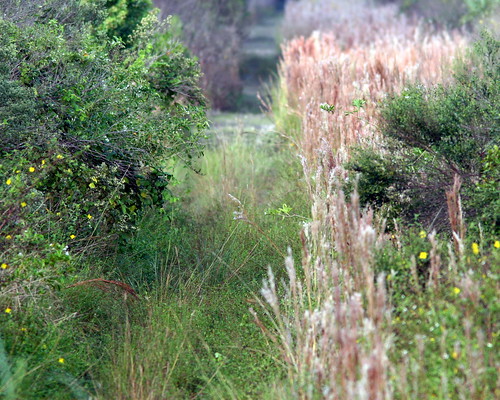
As expected, long-legged waders were taking advantage of the fish “soup.” As I walked down the path, I was startled when herons and egrets, sometimes protesting with a loud “squack,” took flight nearby. A group of Black-crowned Night-Herons kept moving in unison from tree to tree as I progressed down along the canal. Among a group of Great Egrets, a slightly smaller white heron lofted up. Its dingy plumage and pale, dark-tipped bill identified it as an immature Little Blue Heron.
Immature Little Blue Heron:
Adult Black-crowned Night-Herons:
Immature Black-crowned Night-Heron, hiding in the grass: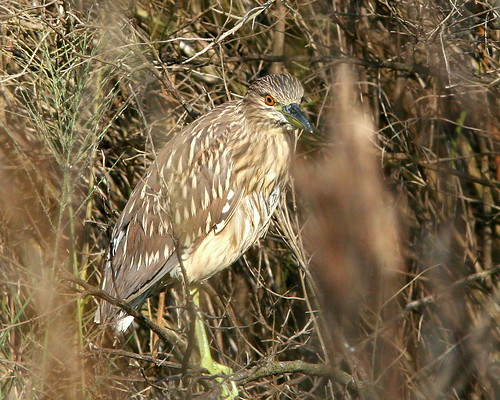
Great Egret, flying away as I approached:
There are two particular hazards along this route. Most common is the danger of stepping on a fire ant nest. When I walked this way last winter, the path was almost free of grass. Now it grew up to a foot high in spots, hiding the ant nests as well as another danger. It is not unusual to encounter Cottonmouth Moccasins along the way. When the grass is low, they are usually visible from a distance. Now I took extra care to look down before I took a step into the grassy areas. While photographing the herons, I caught sight of movement at the edge of the trail, about 5 feet away from me. A three foot Cottonmouth was slithering out from high grass along the path. It was so close that I could not fit its whole body into my camera’s viewfinder, so I stepped back for a better shot. My movement must have frightened the snake, as it quickly turned and moved back out of sight.
Cottonmouth Water Moccasin:
Detail of Cottonmouth’s head, showing black mask and vertical pupil slit:














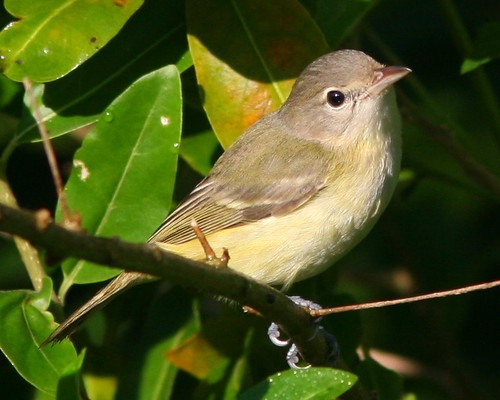
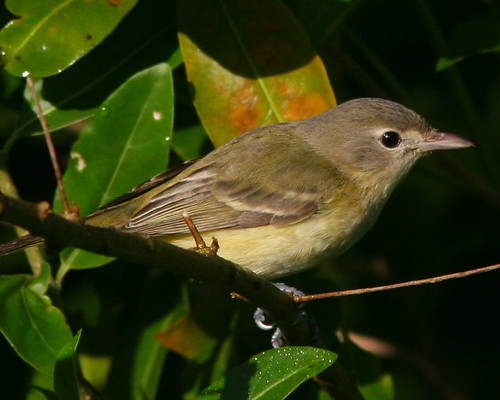
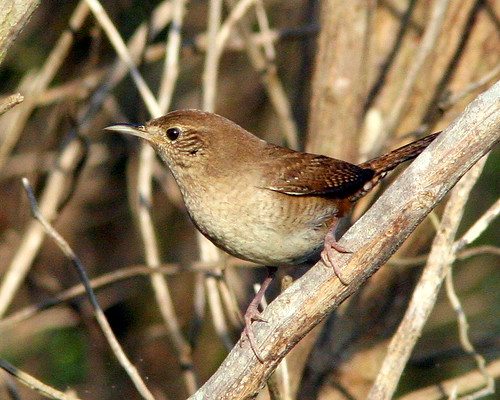
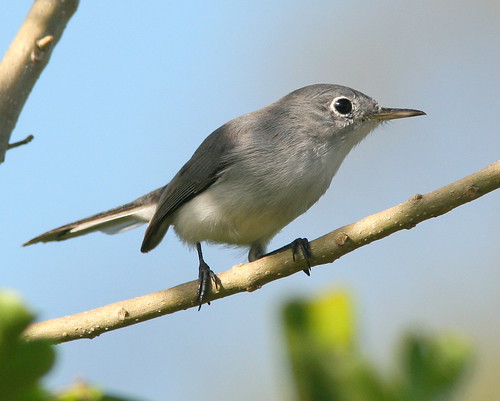
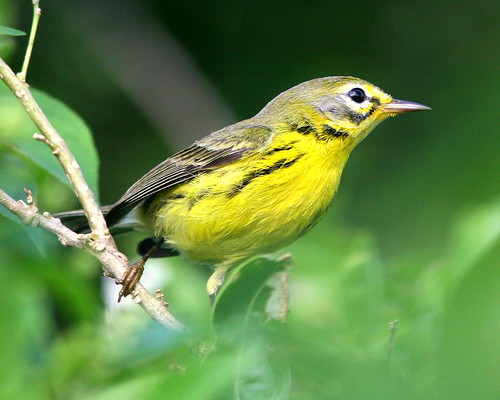

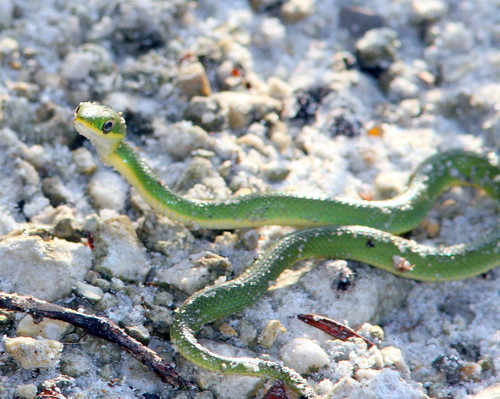
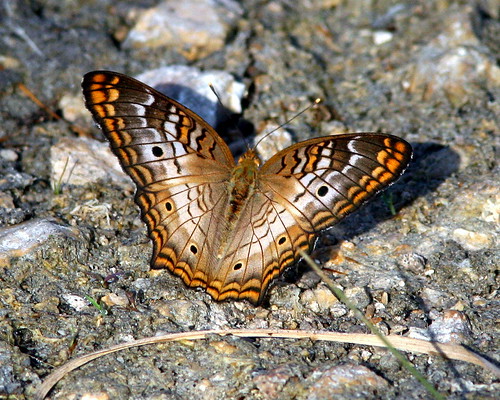

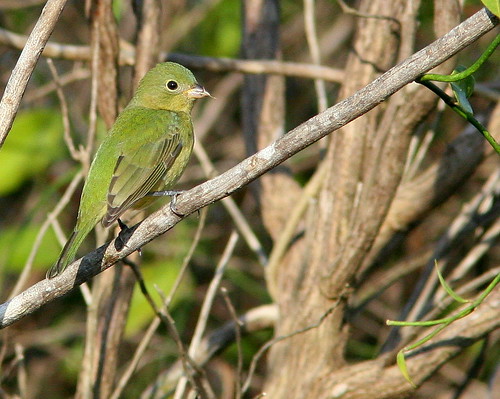

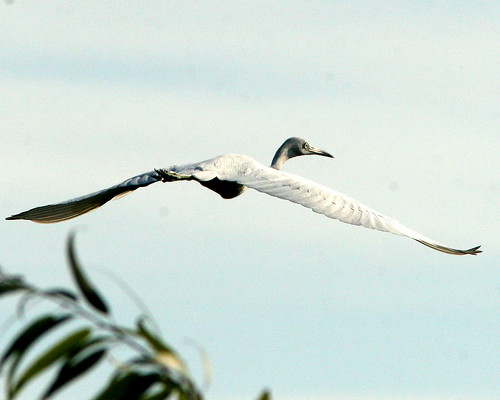
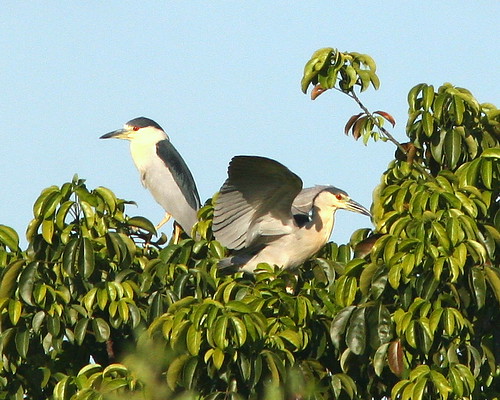
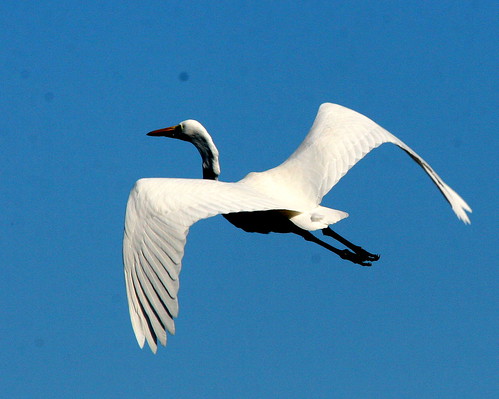
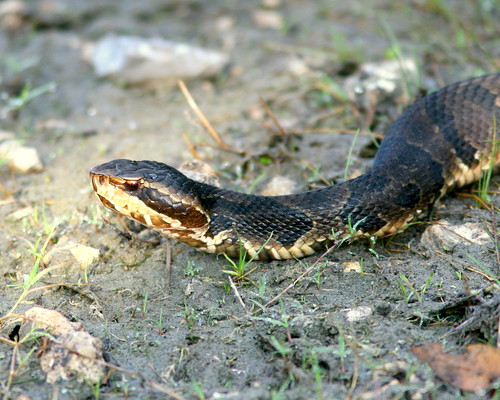

October 25th, 2009 at 2:22 pm Great photos of all the birds - but to a birder from the other side of the world (Australia) the descriptions and photos of the landscape are especially interesting. You live in a fascinating area.
October 25th, 2009 at 4:42 pm Great photos keep a lookout for those snakes.
October 26th, 2009 at 1:13 am OK, I’m officially envious :D I love to see all these fantastic close ups of the small birdies! May I ask what lens (and length of lens) you are using?
October 26th, 2009 at 5:58 am Hi, Nicole– I use a Canon EF 300mm 1:4 L Image Stabilized, with a Canon Extender EF 1.4X, thus providing a focal length of 420mm. All my shots are hand-held, and the weight (with my Canon 30D camera) is tolerable. Thanks for your comments, all!
October 26th, 2009 at 6:22 am MY E-BIRD REPORT FOLLOWS: Location: West Miramar ESL Observation date: 10/23/09 Notes: Bell’s Vireo is documented with 13 photographs, which may be viewed at http://blog.rosyfinch.com Number of species: 38 Double-crested Cormorant 2 Anhinga 1 Great Blue Heron 3 Great Egret 8 Little Blue Heron 1 Tricolored Heron 1 Green Heron 1 Black-crowned Night-Heron 6 White Ibis 10 Black Vulture 12 Turkey Vulture 15 Osprey 1 Sharp-shinned Hawk 1 Cooper’s Hawk 2 Red-shouldered Hawk 1 Killdeer 2 Rock Pigeon 15 White-winged Dove 2 Mourning Dove 4 Belted Kingfisher 2 Loggerhead Shrike 1 Bell’s Vireo 1 Blue Jay 16 Carolina Wren 1 House Wren 12 Blue-gray Gnatcatcher 6 Gray Catbird 25 Northern Mockingbird 15 European Starling 10 Yellow-rumped Warbler 2 Palm Warbler 10 Common Yellowthroat 20 Eastern Towhee 3 Northern Cardinal 1 Indigo Bunting 2 Painted Bunting 1 Common Grackle 8 Boat-tailed Grackle 6 This report was generated automatically by eBird v2(http://ebird.org)
October 26th, 2009 at 8:01 pm great birding, and great photos. I like them all, but of course the wren is my favorite.
October 27th, 2009 at 10:18 pm Ken, your descriptions are amazingly detailed and make me feel like I’m right there, seeing everything you see. Your photographs are excellent and your knowledge of the water courses in Florida are very informative. Since you don’t have an “about me” page, I was wondering if you might give us an idea of what you did for a living. I assume you are retired because it says in your header that you are a “snow-birder”. I’m just curious because of all the great knowledge you pass on to all of us. Thank you for your informative post and of course the great bird photos.
October 28th, 2009 at 2:56 pm Thanks, Larry. Yes, I am a retired physician. I took up photography last year when my son-in-law gave me his Canon D30 after he upgraded. Before that I did some digiscoping with my 2 megapix point-and-shoot. Retired to the mountains of New Mexico, where I volunteered with State Parks and US Forest Service as a docent/wildlife information specialist. Loved it, but after 11 years moved to Florida to be nearer to our daughter who had just adopted two little girls.
Her husband got a promotion to Chicago just as I was watching the last of the furniture being put on the truck back in NM! That led to us buying a second home in Illinois a couple of years ago. We do like the Florida winters, but I miss New Mexico’s culture and natural beauty.
My wife, Mary Lou, and I started a rosy-finch feeding program at Sandia Crest outside Albuquerque, and it has been very successful. I still keep track of the rosies’ comings and goings in my Web suite. We also host a forum for watchers at an urban Bald Eagle nest that was discovered near our Florida home early last year, the first in our county since DDT was abolished in the 1970s.
Am now on the Mayor’s Steering Committee to create an eagle sanctuary. I especially enjoy birding in “patches” near home– seeing the same old birds but enjoying them more and more. Explore the links below– my Flickr photos include early digiscope images, nearly all through the windows of my great room in New Mexico.
Best wishes, Ken
Web site: http://www.rosyfinch.com
Local Eagle Nest: http://www.rosyfinch.com/BaldEagleNest.html
Sandia Crest Birding Forum: http://rosyfinch.com/Rosy-FinchFORUM.html
Blog: http://blog.rosyfinch.com
Photos: http://flickr.com/photos/rosyfinch